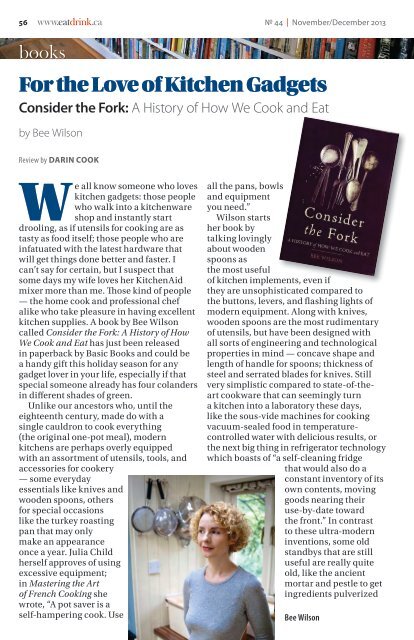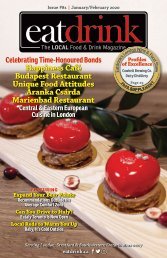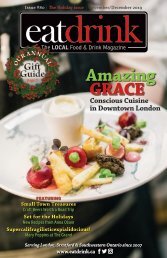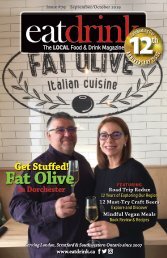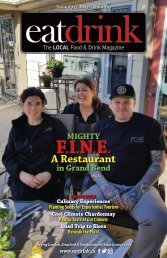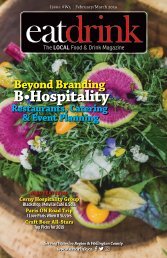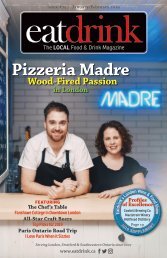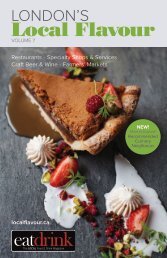Eatdrink #44 November/December 2013
The LOCAL food and drink magazine serving London, Stratford and Southwestern Ontario since 2007.
The LOCAL food and drink magazine serving London, Stratford and Southwestern Ontario since 2007.
You also want an ePaper? Increase the reach of your titles
YUMPU automatically turns print PDFs into web optimized ePapers that Google loves.
56 www.eatdrink.ca<br />
№ 44 | <strong>November</strong>/<strong>December</strong> <strong>2013</strong><br />
books<br />
For the Love of Kitchen Gadgets<br />
Consider the Fork: A History of How We Cook and Eat<br />
by Bee Wilson<br />
Review by Darin Cook<br />
We all know someone who loves<br />
kitchen gadgets: those people<br />
who walk into a kitchenware<br />
shop and instantly start<br />
drooling, as if utensils for cooking are as<br />
tasty as food itself; those people who are<br />
infatuated with the latest hardware that<br />
will get things done better and faster. I<br />
can’t say for certain, but I suspect that<br />
some days my wife loves her KitchenAid<br />
mixer more than me. Those kind of people<br />
— the home cook and professional chef<br />
alike who take pleasure in having excellent<br />
kitchen supplies. A book by Bee Wilson<br />
called Consider the Fork: A History of How<br />
We Cook and Eat has just been released<br />
in paperback by Basic Books and could be<br />
a handy gift this holiday season for any<br />
gadget lover in your life, especially if that<br />
special someone already has four colanders<br />
in different shades of green.<br />
Unlike our ancestors who, until the<br />
eighteenth century, made do with a<br />
single cauldron to cook everything<br />
(the original one-pot meal), modern<br />
kitchens are perhaps overly equipped<br />
with an assortment of utensils, tools, and<br />
accessories for cookery<br />
— some everyday<br />
essentials like knives and<br />
wooden spoons, others<br />
for special occasions<br />
like the turkey roasting<br />
pan that may only<br />
make an appearance<br />
once a year. Julia Child<br />
herself approves of using<br />
excessive equipment;<br />
in Mastering the Art<br />
of French Cooking she<br />
wrote, “A pot saver is a<br />
self-hampering cook. Use<br />
all the pans, bowls<br />
and equipment<br />
you need.”<br />
Wilson starts<br />
her book by<br />
talking lovingly<br />
about wooden<br />
spoons as<br />
the most useful<br />
of kitchen implements, even if<br />
they are unsophisticated compared to<br />
the buttons, levers, and flashing lights of<br />
modern equipment. Along with knives,<br />
wooden spoons are the most rudimentary<br />
of utensils, but have been designed with<br />
all sorts of engineering and technological<br />
properties in mind — concave shape and<br />
length of handle for spoons; thickness of<br />
steel and serrated blades for knives. Still<br />
very simplistic compared to state-of-theart<br />
cookware that can seemingly turn<br />
a kitchen into a laboratory these days,<br />
like the sous-vide machines for cooking<br />
vacuum-sealed food in temperaturecontrolled<br />
water with delicious results, or<br />
the next big thing in refrigerator technology<br />
which boasts of “a self-cleaning fridge<br />
that would also do a<br />
constant inventory of its<br />
own contents, moving<br />
goods nearing their<br />
use-by-date toward<br />
the front.” In contrast<br />
to these ultra-modern<br />
inventions, some old<br />
standbys that are still<br />
useful are really quite<br />
old, like the ancient<br />
mortar and pestle to get<br />
ingredients pulverized<br />
Bee Wilson


